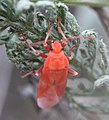Knight bug
| Knight bug | ||||||||||||
|---|---|---|---|---|---|---|---|---|---|---|---|---|

Knight bug ( Lygaeus equestris ) |
||||||||||||
| Systematics | ||||||||||||
|
||||||||||||
| Scientific name | ||||||||||||
| Lygaeus equestris | ||||||||||||
| ( Linnaeus , 1758) |
The knight bug ( Lygaeus equestris ) is one of the most common types of bug in Central Europe from the family of ground bugs (Lygaeidae). The knight bug was the insect of the year in Germany and Austria in 2007 .
features
Knight bugs are about eleven to twelve millimeters long when fully grown. You can recognize them by the red and black markings on their body surface, the fully developed wings and the long, strong legs. The black spots on the top form a pattern reminiscent of a knight's cross, which the German name of this bug refers to. Another characteristic is a circular white spot on each of the membranes, the forewings ( hemielytras ) , which are characteristic of bedbugs . Since the membranes overlap, they appear to be united into a single spot.
They can be confused with the common fire bugs ( Pyrrhocoris apterus ).
distribution and habitat
The species is distributed from southern England to Siberia and from central Sweden to the Mediterranean . It is rarer north of the low mountain range . This species is often found in warmer locations on dry grass , in sparse forests, on bushes and on ruderal areas . The animals often run around sociable on the ground or climb on plants.
Way of life
The red and black drawing of knight bugs has a deterrent effect and serves to protect the animals (Müllerian or Batessian mimicry ). Larger concentrations of such species increase the deterrent signaling effect against predators . Like many bedbugs, the knight bug feeds on plant juices. It lives in particular on swallowweed ( Vincetoxicum hirundinaria ), spring Adonis flower ( Adonis vernalis ) and sometimes also on dandelions . By storing or converting the poisonous constituents of their food plants, they become inedible for potential predators.
A partner is found using sounds that are barely audible to the human ear. The act of mating can take up to 24 hours. The eggs are laid in the loose floor litter. The animals live to be around one year old and overwinter in the adult stage.
Stages of development
The following pictures show several stages of development of the knight bug as a nymph.
literature
- Helgard Reichholf-Riehm: Insects. Mosaik-Verlag, Munich 2000, ISBN 3-572-01088-8 .
- E. Security guard : watch bugs - get to know. J. Neumann - Neudamm, Melsungen 1989, ISBN 3-7888-0554-4 .
- E. Wachmann, A. Melber & J. Deckert (2007), Bugs 3 - Tierw. Deutschlds., 78, pp. 42-46, ISBN 978-3-937783-29-1
- TJ Henry: Phylogenetic analysis of family groups within the infraorder Pentatomomorpha (Hemiptera: Heteroptera), with emphasis on the Lygaeoidea. In: Annals of the Entomological Society of America. 90, 1997, pp. 275-301.
Web links
- Fauna Europaea: taxonomy
- "Award - Steep Career: Wanze makes it to Insect of the Year 2007" (article in Die Welt on November 24, 2006)








